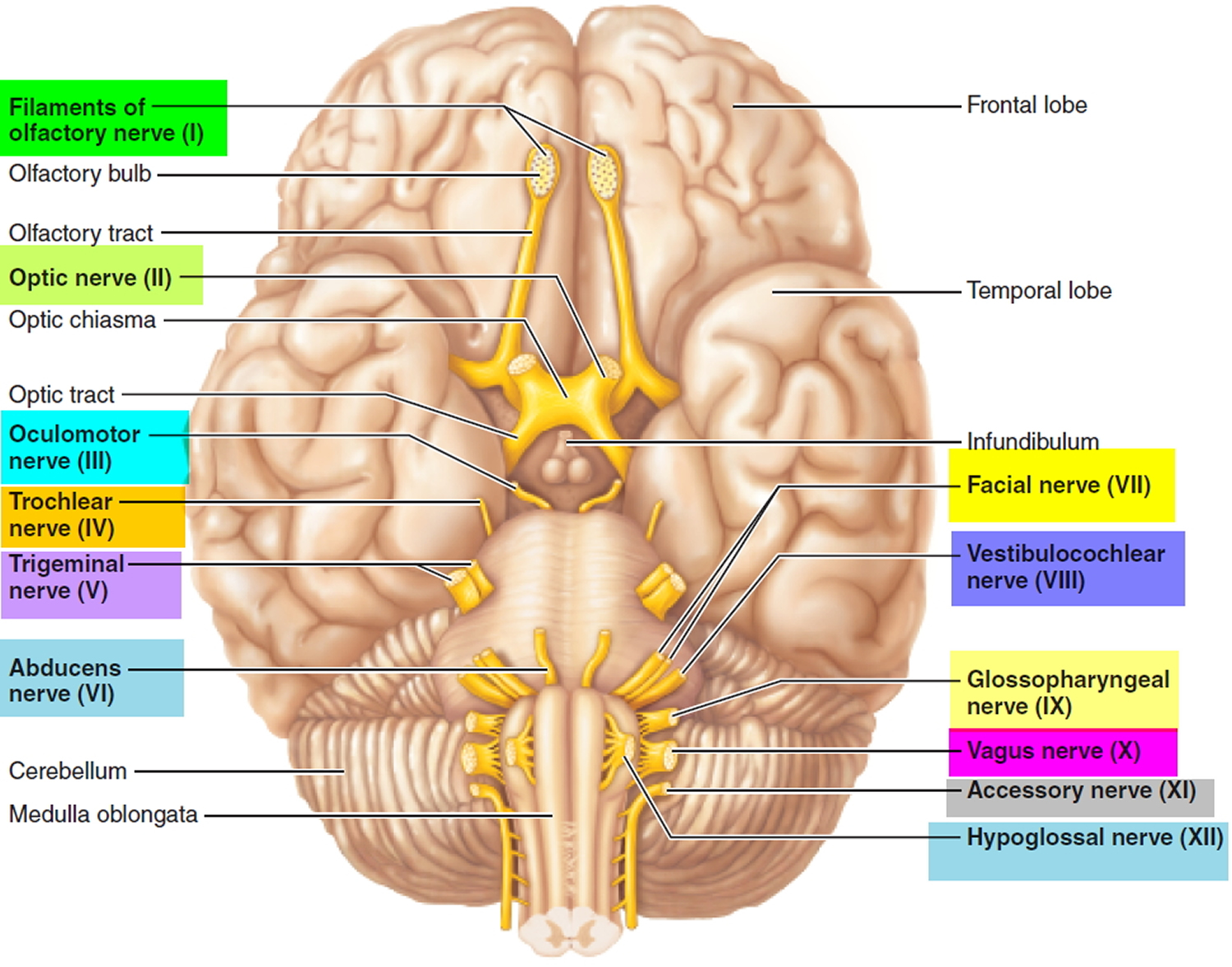Cranial Nerves Anatomy and MCQs For NEET, SSC, GPAT, Staff Nurse and CSIR NET JRF Exam
CRANIAL NERVES
There are 12 pairs of cranial nerves which originate from the nuclei in the inferior surface of the brain, out of which some are sensory some are motor nerves and the remaining one are the mixed nerves that means that they are both motor as well as sensory nerve. The mains of these nerve symbolizes their distribution and function. These nerves are numbered according to their connection with brain anteriorly, which are as follows-
I. Olfactory nerve:- sensory
II. Optic nerve:- sensory
III. Oculomotor nerve:- motor
IV. Trochlear nerve:- motor
V. Trigeminal nerve:- mixed
VI. Abducent nerve:- motor
VII. Facial nerve:- mixed
VIII. Vestibulocochlear nerve:- sensory
IX. Glossopharyngeal nerve:- mixed
X. Vagus nerve:- mixed
XI. Accessory nerve:- motor
XII. Hypoglossal nerve:-motor
To make our learning easier, I have provided the information related to the function, origin etc of nerve in the table give below
| Name of the nerve | Central connection | Peripheral connection | functions |
| Olfactory | Smell area in the temporal lobe of cerebrum | Mucous membrane in the root of nose | Sense of
smell |
| Optic | Sight area in the occipital lobe of cerebrum | Retina of
The eye |
Sense of
sight |
| Occulomotor | Nerve cells in the aqueduct of midbrain | 1.Superior, inferior, medial rectus muscle of eye
2.Ciliary muscle of the eye 3.Circular muscle fibers of iris |
1. movement of the eyeball
2. focusing regulating of the size of the pupil. |
| Trochlear | Nerve cells near the floor of aqueduct of midbrain | Superior oblique muscle of the eye | Movement of the eyeball |
| Trigeminal | Motor fibers from pons
Sensory fibers from trigeminal ganglia |
Muscles of mastication
Sensory to gums cheek lower jaw, iris and cornea |
Chewing
Sensation from face. |
| Abducent | Floor of fourth ventricle | Lateral rectus muscle of the eye | Movement of the eye |
| Facial | Pons | Sensory fibers to the tongue
Motor fibers to the muscle of face |
Sense of taste
Movement of facial expressions |
| Vestibulo-chochlear
a. vestibular branch b. cochlear branch |
Cerebellum Hearing area of cerebrum |
Semicircular canals of inner eye
Organ of corti |
Balance maintenance
Sense of hearing |
| Glossopharyngeal | Medulla oblongata | Parotid gland
Back of tongue and pharynx |
Secretion of saliva, sense of taste and movement of pharynx |
| Vagus | Medulla oblongata | Pharynx larynx and organs, ducts gland of thorax and abdomen | Movement and secretion |
| Accessory | Medulla oblongata | Sternocleidomastoid , trapezius laryngeal and pharyngeal muscle | Movement of head shoulder larynx and pharynx |
| Hypoglossal | Medulla oblongata | tongue | Movement of tongue
|

Multiple choice questions(MCQs)
1. how many pairs of cranial nerves are present?
a. 12 b. 10
c. 13 d. 14
2. From where are the cranial nerves originated?
a. from nuclei in the superior surface of the brain
b. . from nuclei in the posterior surface of the brain
c. . from nuclei in the inferior surface of the brain
d. from nuclei in the anterior surface of the brain
3. where is the peripheral connection of optic nerve?
a. ciliary muscle of eye b. retina of eye
c. lateral rectus muscle of eye d. superior oblique muscle of eye
4. which of the following nerves are responsible for the movement of eye?
a. abducent nerve b. trochlear nerve
c. occulomotor nerve d. all of the above
5. which of the following statement is NOT true?
a. the nerves are numbered according to their connection with brain posteriorly
b. accessory nerve is a motor nerve
c. facial nerve functions for facial expressions
d. the central connection of abducent nerve is from floor of fourth ventricle
6. where is the central connection of facial nerve?
a. medulla oblongata b. pons virolii
c. cerebrum d. cerebellum
7. which of the following nerve is a mixed nerve?
a. optic nerve b. hypoglossal nerve
c. trochlear nerve d. none of the above
8. which of the following nerve is responsible for sense of taste?
a. abducent nerve b. facial nerve
c. hypoglossal nerve d. none of the above
9. Match the following-
A. abducent nerve 1. Vagus nerve
B. hypoglossal nerve 2. Lateral rectus muscle of eye
c. medulla oblongata 3. tongue
d. aqueduct of midbrain 4. Occulomotor nerve
10. What is the function of olfactory nerve?
a. sense of smell b. sense of hearing
c. sense of taste d. maintaining balance
ANSWERS:-
1. 12
2. nuclei in the inferior surface of brain
3. all of the above
4. retina of the eye
5. the nerves are numbered according to their connection with brain posteriorly
6. pons
7. none of the above
8. facial nerve
9. a – 2 b – 3 c – 1 d – 4
10. sense of smell
Participate in Online FREE GPAT TEST: CLICK HERE
Participate in Online FREE Pharmacist TEST: CLICK HERE
Participate in Online FREE Drug Inspector TEST: CLICK HERE
REFERENCE:
1. Ross and Wilson-Anatomy and physiology in health and illness; 12th edition; page no.-: 170-172.